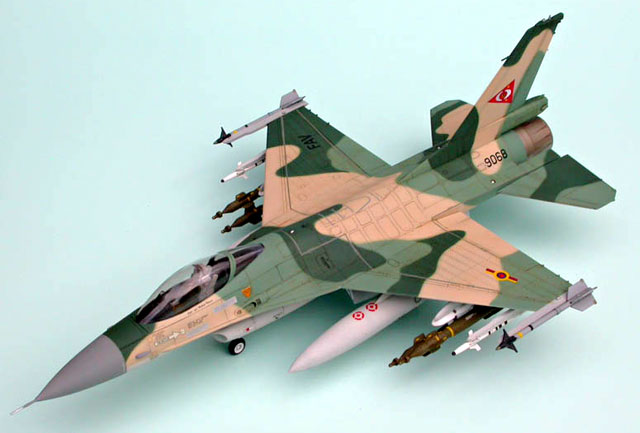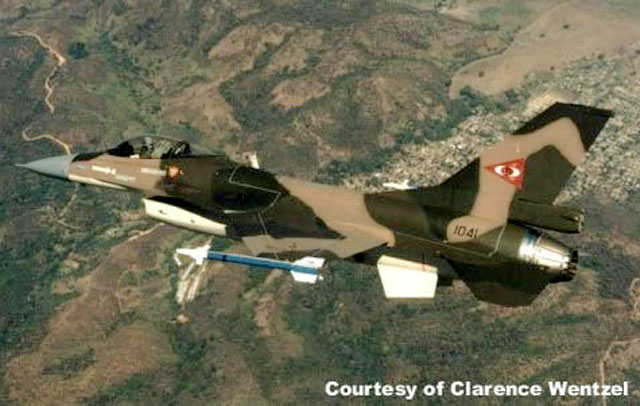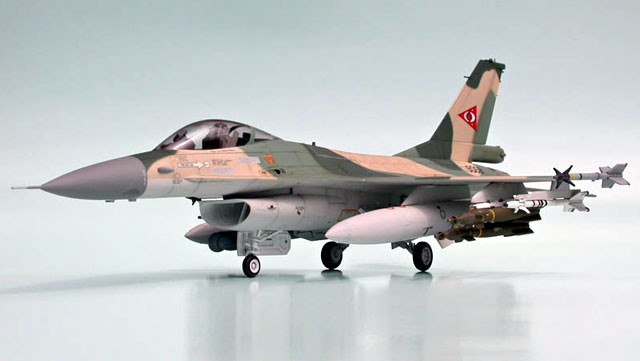|
F-16A "Venezuelan
Viper"
by Fabian Nevarez
|

|
|
F-16A "Venezuelan Viper" |

HyperScale is proudly supported by
Squadron.com
In May of 1982, the government of Venezuela signed an agreement to
buy 18 Block 15 F-16As and six Block 15 F-16Bs to replace the fleet of
Mirage III interceptors and Mirage 5 ground-attack aircraft serving with
the Fuerza Aérea Venezolana (FAV). This purchase was under the Peace
Delta Foreign Military Sales program, and took a long time to be
approved, because the US government wanted to sell Venezuela the F-16/79
instead. However, in 1983, the US government finally approved the sale
of the F100-powered F-16 to Venezuela, and the first aircraft was
accepted for the Venezuelan Air Force in September of 1983. Final
delivery took place in November 1985 when the 24th aircraft arrived at
El Libertador AB.
Original Colors
These Fighting Falcons were unique in having a "jungle" camouflage
scheme in colors similar to those used by the USAF during the Vietnam
war, composed of (approximate colors)
-
Dark Green (FS34079),
-
Medium Green (FS34102),
-
Tan (FS30219) and
-
Light Gray (FS37875),
applied at General Dynamics' Forth Worth plant.

Operations and Upgrades
The parent unit is Grupo Aero de Caza No. 16, which operates
Escuadron 161 "Caribes" and Escuadron 162 "Gavilanes", both based at El
Libertador AB, Palo Negro. Although originally bought to replace the
fleet of 24 Mirage III V and 5V, the FAV decided to update these planes
and convert them to Mirage 50. In 1990, the FAV retired their Canberras
from service and the F-16 took over their ground attack role. Pilots of
both squadrons are trained on the roles of air defense, ground attack,
air superiority and interception.
Starting in 1997, a series of programs were implemented, aimed at
fielding the LITENING laser designator and infrared navigation pod
produced by Rafael in Israel; to replace the Litton AN/ALR-69 radar
warning receiver with an enhanced Elisra SPS-2000 RWR also from Israel
as well as installing the Litton LN-93 ring laser gyro. The Litening pod
provided the FAV with a capability to use precision-guided munitions,
such as the 500-pound GBU-12 and 1,000-pound GBU-10 laser-guided bombs
and other PGM of Israeli manufacture that are now part of FAV's
inventory. In a similar manner, Grupo 16 also acquired night vision
capability for its F-16s, which encompassed installing cockpit and
external lighting that is fully compatible with night vision goggles.
FAV F-16`s were also updated to receive the Lima version of the
Sidewinder missile to be used along the AIM-9P already in service.
Another major program was the refurbishment of the F100-PW-200 engines
to bring them up to PW-220E standard.
The Litening pod and the NVG capability of the FAV F-16s account for the
F-16s being called into night action to counter illegal border
incursions and illegal incursions into Venezuelan air space. In the
latter missions, the infrared capabilities of the Litening pod, designed
primarily for air-to-ground use, provided the FAV with a useful
instrument in the air-to-air regime as well because the system aids
nighttime intercepts.
New Colors

Along with these upgrade programs, the entire fleet of F-16s was
gradually repainted, retaining the same basic scheme patterns but
different hues where locally applied. This time the (approximate) colors
used were SAC Dark Green (FS31092), Pale Green (FS34373), Sand (FS36642)
and Light Gray (FS37875) giving way to a more vivid, peculiar scheme.
Building a
Venezuelan Viper in 1/48 Scale
|
Hasegawa's F-16A Plus
For this project in which I depict the current, upgraded version of
the FAV Falcons, I started with Hasegawa's F-16A-plus kit that I already
had, knowing that I would had to add the extended drag chute housing,
peculiar to Venezuelan Vipers.
For this item I borrowed the spare
housing from the Italeri F-16B/D kit that, after removing Hasegawa's
original housing and some sanding and dry-fitting, assembled perfectly
without need for putty.

I also added the RWR antennas to it and moulded
the parachute pack out of Milliput. After I made these changes, the
construction went forward without major problems, except for the very
bad air intake/duct assembly typical of Hasegawa's 1/48 Falcons.
Once the airframe was completely assembled I pre-shaded all panel
lines with "aircraft interior black" color in preparation for the first
coat of camouflage. After doing some research I decided to go for my own
selection of colors since all my references contradicted themselves for
the "right" colors to be used. Based on a good amount of pictures from
different sources I selected the FS33531 for the Sand coat which I
applied very thinned to the whole topside to gradually cover the
pre-shaded panels, giving a lighter pass in the areas intended for the
green tones and then I left it to dry overnight.

Next I depicted the
Medium Green patterns with rolled strings of Blu-Tack and masked-off the
Sand patterns with paper tape. For the Medium Green I prepared my own
color by mixing Russian Interior Green, Russian Topside Green and a few
drops of Medium Gray. Some hours later I masked for the Dark Green
patterns and applied a couple of light coats of "European Dark Green"
mixed with one or two drops of US Dark Green. Finally I hard-masked the
division between topside and underside and applied several thinned coats
of Light Gray FS36495 to smoothly cover the pre-shaded panels on the
bottom side of the model.
A coat of Future followed and once it dried I applied the FAV markings
using decals from Aztec's "Latin Eagles II" set, conformed to recessed
areas with the help of MicroSol. Stenciling and walkways came from the
kit's own set since Venezuelan Vipers carry all aircraft data in
English, plus some others from a SuperScale F-16 data sheet. Later, a
second coat of Future was given to seal the decals and then I proceeded
to enhance the recessed panel lines and lightly weathering the model by
giving a wash with artists' oil paint (burnt umber) diluted in
turpentine. Finally, a coat of DullCote lacquer was applied to flatten
the whole finish.
Bombs and missiles came from various Hasegawa Weapons sets kindly
supplied by Gary Ferris as well as the LANTIRN pod which I modified by
means of surgery and decals to resemble the Israeli-made LITENINIG pod,
following several drawings and suggestions provided by Mr. Ferris.

The Litening pod was painted in FS35164 Intermediate Blue. Decals
came from the Hasegawa Lantirn pod and some others made from scratch
decal sets.
The model was finished in approximately one month's time and all in
all, a very interesting subject to research and build and an
eye-catching addition to my Latin American collection.
Acknowledgements
and Sources
|
Acknowledgements
To Clarence Wentzel, Ivan Peña and Richard Tovar from FAV-Club for
allowing me to use their original photographs and info in this article
and to fellow Hyperscaler Gary Ferris for providing the Hasegawa weapons
and information on the Litening pod.
References
Click
the thumbnails below to view larger images:
Model, Images and Text Copyright © 2002 by
Fabian Nevarez
Page Created 21 October, 2002
Last Updated 04 June, 2007
Back to HyperScale
Main Page
Back to Features Index
|
Home
| What's New |
Features |
Gallery |
Reviews |
Reference |
Forum |
Search